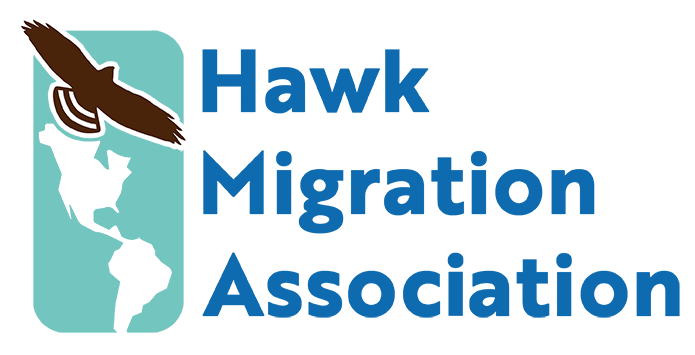It is hot with tiny gnats fighting to get into my eyes in early July as I scramble over boulders on the mountain slope, sweating out whatever water I just drank, hoping to see or hear broad-winged hawks. Every year there is one nesting pair that hides its nest so well we cannot find it. It becomes a mission and obsession driven more by faith than reason. I know they are here somewhere. The nesting territory has added importance as we tagged the male last year with a small, 5-gram solar-powered satellite transmitter. The unit regularly signaled through July 2019 and then cut out. These relatively new models have not been used on forest raptors often before, so we were afraid this might happen. In 2019, only one unit on a male bird signaled for the southbound migration before also cutting out in January 2020. Brady, the one male we tracked, wintered in Brazil. This bird, who I know is here, is David, named for one of our faithful donors. Flash forward to mid-August, a broadwing passes close by Hawk Mountain’s North Lookout sporting a transmitter. Was that David, it could be? You can be sure I will be out in April waiting for him to return.
Every spring and summer since 2014, we have been placing small 9 gram transmitters on female Broad-winged Hawks to understand better the conservation threats they face and learn about their migration ecology. In 2019, we unsuccessfully tried to compare male ecology to females. However, throughout this six-year adventure, I have enjoyed most quiet times with nesting broadwings in the forest when they let me observe their behavior and the exciting discoveries this research allows.
Just by example, let me tell you the story of Rosalie.
Rosalie, named for Hawk Mountain founder Rosalie Edge, has nested in the Hawk Mountain lower slope since 2014. We trapped and tagged her in 2016, and every year we have observed her successfully bringing off young even amid a drought. She wintered in the tropical forest of southern Peru for three years traveling 5,400 miles one way between Pennsylvania and Peru. Since we have tracked her nest every year, I have enjoyed the nest checks at her nest, especially even the fiery glares she gave.
In September 2019, Rosalie was migrating across Louisiana when suddenly her transmitter stopped moving for several weeks. We kept getting signals, but it was mostly from one spot. We tried to get someone to go out and see what happened without success. We knew there were two possibilities, she dropped the transmitter, and two, she was dead. The second possibility was highly likely as migration is a tenuous time for raptors with natural and unnatural threats everywhere. I secretly fretted while my colleague Rebecca McCabe held out hope. In May 2020, we found a nest in her old territory but were unsure who the female was tending it to. Zach Bordner, our field assistant, set up a watch at the nest site with his telescope and waited for the incubating female to rise off the nest. By days’ end, he reported seeing her distinct color bands and silver band! She had returned! We were ecstatic. The transmitter is attached with a particular thread that will break after several years, releasing the bird from the backpack unit.
In our long-term study of Pennsylvania Broadwings, we have learned that each bird will stopover on migration regularly for an average of several days, presumably to rest and forage. Each migration can take 80 to 100 days, and they all show high fidelity to winter and summer homes. PA adult females wintered in Colombia, Brazil, and Peru. Juveniles (n=3) we tagged wintered in Mexico through Panama. Three birds tagged in Alberta by Smithsonian Migratory Bird Center and their colleagues at the University of Alberta all wintered from Brazil to Surinam, east of PA birds.
This year we had hoped to tag females in New Hampshire and Connecticut to see if they might show different behavior or winter areas. Such differences have implications for conservation and are essential to discern.
However, we could not visit trapping and tagging broad-winged hawk adults in 2020 due to Covid-19 restrictions. Despite this setback, hard-working New Hampshire and Connecticut volunteers successfully located nests in those areas preparing for our next year’s visit. Knowing locations of territories is a huge step forward on finding nests next year, so their work was not wasted by any means!
In Pennsylvania, the field crew verified several returning Broadwings, both female and males. We demonstrated that Broun and Paula, a pair that had been sighted together for a few years, had produced. We re-trapped Broun in June 2020 and removed his malfunctioning transmitter. Paula was sighted often but avoided recapture. However, she raised three young successfully, and we can try again next year.
Rosalie raised four young (see left here), which is the most visited in any Broad-winged nest! Another formerly-tagged female in Delaware State Forest of eastern Pennsylvania, Sadie (see below), was photographed by collaborator Dr. Terry Master on her territory. She was a welcome sight as it represents four years she has returned from her winter home in Peru.
The Broadwing Team also celebrated the completion of two manuscripts, one was published in Wilson Journal of Ornithology on migration patterns, and another was accepted on wintering habitat and threats for publication in 2021. Below is an infographic we created to display critical results on the migration research paper. If interested in the full article, visit the scientific publication section of Hawk Mountain website, www.hawkmountain.org.
We thank our wonderful supporters for their generosity. If you stand atop lookouts across North America discussing migration questions, you might take a look at our research results. We are getting some answers! And, we are looking forward to next June when we can travel to New England and begin to understand more about where different populations of broadwings may winter.
Enjoy the migration!
Best regards and be safe,
Laurie Goodrich, Project Investigator



